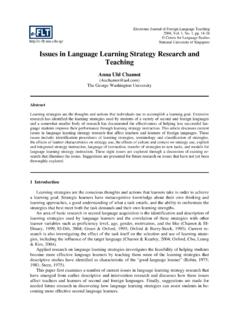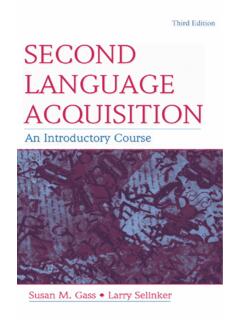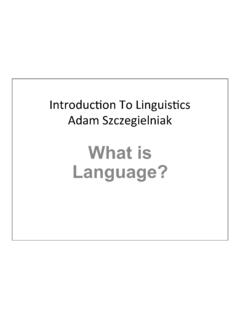Transcription of Four Models of Language Learning and Acquisition and …
1 Electronic Journal of Foreign Language Teaching 2012, Vol. 9, Suppl. 1, pp. 298 311 Centre for Language Studies National University of Singapore Four Models of Language Learning and Acquisition and Their Methodological Implications for Textbook Design Hermann Funk Friedrich-Schiller-Universit t Jena, Germany Abstract This article explores the consequences of four Models of Language Learning and Acquisition on textbook de-sign, and the sequencing and distribution of lesson activities. The model developed by Levelt (1989) to ex-plain oral speech production, which was later extended to second Language Learning by De Bot (1992), points to the importance of lexical knowledge and subconscious, automatic processing. Paul Nation (2001) cited ample evidence for the effectiveness of an equal distribution of meaningful input, Language focused instruc-tion, meaningful output and fluency practice in his four strands model.
2 Segalovitz and Gatbonton (2005) pro-posed the ACCESS-Model, an acronym that stands for automatization in communicative context of essential speech segments. Merrill Swain s model of output hypothesis, which insists that learners learn not only from input but also from output and thus pushes for learner output at an early stage, has also been the subject of much discussion. As far as I can see, none of these four Models have been sufficiently reflected in terms of their consequences for textbook sequences or task and exercise design. Based on practical examples of tasks and exercises, this article will put forward a few ideas and suggestions based on these Models and try to come to some general conclusions with regard to a research-based textbook design. 1 Introduction The history of Language teaching has seen a number of macro-methodological approaches which have had an impact on textbook designs.
3 In the history of Language Learning methods, there have been three main approaches of impact: grammar-translation based approaches audiolingual/audiovisual approaches communicative Language teaching In general, it can be observed that less commonly taught and researched languages are still ba-sically taught and learned with an emphasis on grammar, while internationally more frequently taught languages such as English, German and French have progressed to a communicative ap-proach with an emphasis on Language production and a more implicit approach in the teaching of grammatical structures. Textbook designs have adhered to these principles more or less strictly, often mixing approaches and designs. 50 years since the beginning of modern research in Language teaching, there is still surprisingly little evidence of cause-and-effect classroom research as far as the practical use of textbooks is concerned.
4 All different approaches can cite success stories of learners and courses to support their own claims of effectiveness. Since we have no clear picture of why people succeed or fail in learn-ing languages, for which there may be a multitude of potential reasons, it is not easy to gather evi- Four Models of Language Learning and Acquisition 299 dence for the success of the various methods and to establish the reasons behind their success. The main reason lies in an yet unresolved research problem: While it seems comparatively easy to sin-gle out specific factors of successful Learning under experimental laboratory conditions, it seems practically impossible to attribute success and failure in classroom Learning situations, which are affected by a multitude of visible and invisible factors, many of which are subconscious and there-fore inaccessible through introspection1.
5 This is one of the most persistent problems in human cognition research. It seems fair to say at this point that no single method has managed to produce irrefutable proof of its superiority. In the context of German as a foreign Language (GFL), most researchers current-ly seem to agree on the existence of a post-communicative era, a term first coined by Hans-Eberhard Piepho in the late 1980s. The term refers to an eclectic approach which applies methodo-logical tools stemming from more than one approach, mixing teaching and Learning strategies fo-cusing both on grammar and fluency training. Another frequently used term post-method era. Post-method may not seem very precise after all, we are still following methodological consider-ations but it does imply that the era of macro-methodological approaches is over and that no sin-gle method can claim to encapsulate the multitude of research findings in Language Acquisition .
6 The present situation of Language education research with respect to textbook design can thus be summarized as follows: There is a varied range of different Learning cultures scenarios and exercises cannot be described within the framework of a single methodological concept; Most international curricula and textbooks cannot be attributed to a single method. More often than not, they incorporate a variety of methodological approaches; Individual exercises, on the other hand, cannot be labeled communicative or audiolin-gual without taking their contexts into account; The quality of an exercise ought to be measured with reference to its contribution to a communicative task if we agree that communicative output remains the overall goal; It is clear and verifiable that different methods lead to different results (Long, 2009); On the other hand, there is no proof of the overall superiority of any single methodological approach; The choice of methods depends on the goals for example, if you want to learn how to speak the Language or practice speaking; And this is because there is ample evidence for the principle that time on task is of vital im-portance.
7 This article aims to summarize four major Models of Language Learning and Acquisition that have been proposed as theoretical frameworks for classroom instruction and textbook design, and to discuss their impact on textbook-based Language Learning . The discussion below covers three levels of Language teaching research from theoretical assumptions to principles and standards and finally Models with direct impact on the design of classroom instruction (Funk, 2010). As they cover different aspects of Language teaching, they can be considered complementary. These four Models are: Model 1: Willem Levelt revisited a lexically driven Learning model proposed by the Dutch re-searcher, Willem Levelt, in 1989 and later modified by de Bot in 1992 Model 2: The four strands, a distributional model with classroom focus first proposed by Paul Nation in 2001 (later: Nation & Newton, 2009) Model 3: Merril Swain s model of the output hypothesis, initially meant as a response to Krashen s comprehensible input hypothesis Model 4: The ACCESS model of Elizabeth Gatbonton and Norman Segalowitz (2005), which at-tempts to achieve the reconciliation of different approaches under communicative priorities Hermann Funk 300 I am aware of the fact that there are many more helpful Models that seek to explain Language Learning .
8 However, in regard to textbook design and classroom instructional arrangements, these Models offer two major advantages: 1) They provide explanations of how Language Learning works (in particular, Models 2 and 3), which appear plausible in the light of recent neuroscientific find-ings; and 2) They provide practitioners with guidelines for the planning and distribution of class-room practice. These Models all focus on the central question of how to obtain better and sustainable results in Language classes. Willem Levelt s model, for example, is basically a theory driven concept that calls for practical consequences. Paul Nation s four strands provide a framework of principles, while the ACCESS model and Swain s output model aim at providing progressional concepts and classroom scenarios. The Models also take into account that we have moved beyond the credo of instructionism and constructivism of the 1990s, acknowledging that Learning is basically the construction of meaning, which can be assisted by the arrangement of materials by teachers and textbooks in instruction.
9 Teaching and hence textbooks can provide materials and feedback, map out a path of Learning , give support and counsel, and steer and encourage the construction of meaning, which occurs most frequently and is most effective in social and topic-based interactions with focus on communica-tive tasks. Textbook authors and teachers face the same challenge to provide opportunities and create real or virtual Learning environments which make both intentional and explicit as well as implicit and incidental Learning more likely to happen. One of the main challenges for teachers and textbook authors is the creation and arrangement of Learning scenarios that enable and promote implicit and incidental Learning (for the importance of subconscious processes, see Eagleman, 2011). The interaction between learners and textbooks in educational settings can be summarized as in Figure 1: Fig.
10 1. Interaction between learners, Learning environment and teaching materials (see Reinmann-Rothmeier & Mandl, 2001) 2 Willem Levelt revisited When Willem Levelt developed his model of speech production in the late 1980s at the Max-Planck-Institute in Nijmegen, he was seeking to provide an explanation for oral speech production. De Bot subsequently applied his model to second Language Acquisition (see Fig. 2), asserting that L1 and L2 production develops along the same lines. Levelt makes a distinction between a con-Four Models of Language Learning and Acquisition 301 scious speech act (what I want to say), and an intentional act and, on the other hand, its subcon-scious, automatic processing ( from the intention to the formulation and the articulation of an idea), which has received much attention in recent research.










